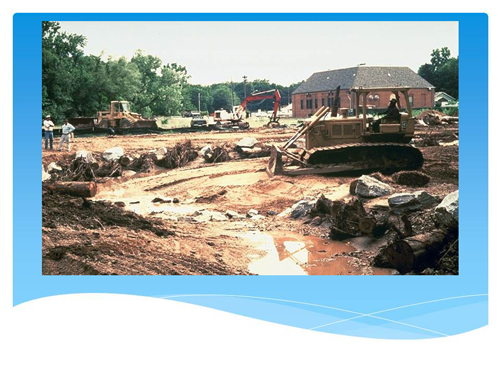Step 3: Finalize Goals and Identify Solutions (cont.)
Selecting Management Strategies (cont.)
In addition to voluntary structural and nonstructural management practices, you should be aware of the practices that are required under regulatory programs and what they will result in over the next 5 to 10 years. Point sources are most often controlled using regulatory approaches however, nonpoint sources can also be regulated to some degree. It’s important to consider that regulatory approaches work well only when adequate mechanisms are in place to provide oversight and enforcement.
Example Regulatory Approaches for Nonpoint Sources:
- Local stormwater ordinances and permits. Local stormwater ordinances require development applicants to control stormwater peak flows, total runoff volume or pollutant loading using stormwater practices such as bioretention cells, stormwater ponds or constructed wetlands. The Center for Watershed Protection’s Stormwater Manager’s Resource Center (www.stormwatercenter.net/intro_ordinances.htm) provides examples of real-world and model ordinances that can be used to guide future growth while safeguarding local natural resources.
- Local development ordinances and permits. Local development and subdivision ordinances require development applicants to meet certain land use (e.g., commercial vs. residential), development intensity, and site design requirements (e.g., impervious surface limits or open space, riparian buffer or setback requirements).
- Federal or state forest land management plans. Corporate, federal and state owners of forestlands are often required to develop and implement forest management plans, which usually include management practices for logging, road construction, replanting and other activities. A number of states also have forestry practice regulations that cover logging practices by individuals or private landowners. Watershed planners can review recent or existing forest management plans in the watershed, discuss with managers which plans and practices are working well, and identify areas that could be strengthened.
- Federal or state grazing permits. Federal or state lands that are leased to individuals often require permits that specify conditions and management practices that must be adhered to for the term of the permit. Watershed planners can also review these permits.
- State regulatory authority. Some states also have the authority to regulate nonpoint sources.
- Agreements for trading. Agreements for trading between point and nonpoint source loads can help distribute the load reduction burden.
Point sources are regulated under the National Pollutant Discharge Elimination System (NPDES) permit program. Authorized by the Clean Water Act, the NPDES permit program controls water pollution by regulating point sources that discharge pollutants into waters of the United States. The NPDES program covers discharges from industrial facilities, municipal stormwater conveyances, concentrated animal feeding operations (CAFOs), construction sites, publicly owned treatment works (POTWs), combined sewer overflows (CSOs) and sanitary sewer overflows (SSOs).
![[logo] US EPA](https://www.epa.gov/epafiles/images/logo_epaseal.gif)






